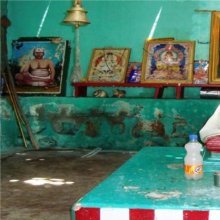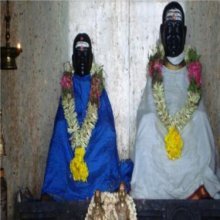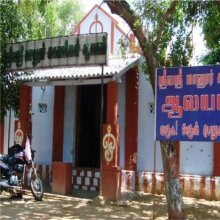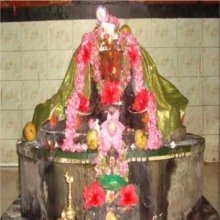Village: 4 definitions
Introduction:
Village means something in Hinduism, Sanskrit, the history of ancient India. If you want to know the exact meaning, history, etymology or English translation of this term then check out the descriptions on this page. Add your comment or reference to a book if you want to contribute to this summary article.
Images (photo gallery)
(+78 more images available)
In Hinduism
Shilpashastra (iconography)
Source: Shodhganga: Elements of Art and Architecture in the Trtiyakhanda of the Visnudharmottarapurana (shilpa)A Village follows specific guidelines of ancient Indian Painting (citra), according to the Viṣṇudharmottarapurāṇa, an ancient Sanskrit text which (being encyclopedic in nature) deals with a variety of cultural topics such as arts, architecture, music, grammar and astronomy.—In the context of identification of some particular places through picture, the Viṣṇudharmottarapurāṇa gives some instructions. According to this book, a picture of village should be adorned with some houses along with gardens.

Shilpashastra (शिल्पशास्त्र, śilpaśāstra) represents the ancient Indian science (shastra) of creative arts (shilpa) such as sculpture, iconography and painting. Closely related to Vastushastra (architecture), they often share the same literature.
Shaivism (Shaiva philosophy)
Source: Google books: Genesis and Development of TantraVillages refers to one of the various objectives expected of the Vedic rituals (following the basic pattern of the new and full-moon sacrifice) known as the Kāmyeṣṭis.—to the analysis of W. Caland, the objectives expected of the kāmyeṣṭis are: [e.g., villages] [...], etc. (Cf. Caland 1908: VI–VII). Although Vedic rituals were a reliable way for the people of ancient India to fulfill their objectives, Tantric rites too claim to bring about the attainment of wishes.

Shaiva (शैव, śaiva) or Shaivism (śaivism) represents a tradition of Hinduism worshiping Shiva as the supreme being. Closely related to Shaktism, Shaiva literature includes a range of scriptures, including Tantras, while the root of this tradition may be traced back to the ancient Vedas.
India history and geography
Source: Google Books: Medieval Orissa: A Socio-economic StudyVillages in ancient India (Medieval Orissa) sometimes formed clusters resulting in Urban centers (nagari).—[...] The context in which the township (or Urban centres—nagari) is assigned—the reference is to the grant of 20 vatis of cornland and 10 vatis of homestead land in Jayanagara-gramna—suggest that nagaris in such cases were perhaps extended villages, formed out of a cluster of several contiguous villages and thus assuming physical and consequently, economic dimensions much larger than those of an ordinary village settlement.
Source: Suomen Antropologi: Sacred Trees among the Tamil people of South IndiaBasically every Village in Tamil Nadu (South India) has its own local deities that have their roots in Dravidian history.—Villages typically have a shrine found under a large tree, dedicated to one of the protective local deities and placed at each entrance to the village, while a huge bodhi or neem tree generally serves as a shady place in the centre of the village under which locals gather to chat and relax.. [...] Today, the worship of the indigenous village deities and the Brāhmanic Hindu gods such as Śiva and Viṣṇu, or Kṛṣṇa and Rāma (both incarnations of Viṣṇu) are practiced side by side in the villages of South India.
In almost every village in Tamil Nadu there is a sacred grove dedicated to a local folk deity. Sacred groves are patches of forests that range from a few trees up to hundreds of hectares that consist of traditionally preserved, almost virgin forests maintained through indigenous cultural and religious rituals practiced by the members of community. [...] many sacred groves are located near important water resources which supply the villagers with their daily water. They also protect the ground from soil erosion

The history of India traces the identification of countries, villages, towns and other regions of India, as well as mythology, zoology, royal dynasties, rulers, tribes, local festivities and traditions and regional languages. Ancient India enjoyed religious freedom and encourages the path of Dharma, a concept common to Buddhism, Hinduism, and Jainism.
See also (Relevant definitions)
Starts with: Village ardisia, Village oak geranium, Village rue.
Ends with: Ariimalam Village, Veliliarai village.
Full-text (+6070): Grama, Agrahara, Kheta, Padra, Gramya, Gramakantaka, Sahasrapati, Upashalya, Gramani, Palli, Samvasatha, Gramakama, Dashagramapati, Shatesha, Khetaka, Hunda, Bhasmatula, Gramataksha, Sadvasatha, Gramajata.
Relevant text
Search found 365 books and stories containing Village; (plurals include: Villages). You can also click to the full overview containing English textual excerpts. Below are direct links for the most relevant articles:
Vastu-shastra (2): Town Planning (by D. N. Shukla)
Villages in ancient Indian town-planning < [Chapter 2 - Villages, Towns and Forts in General]
Chapter 1b - Origin and Growth of Indian Towns
Towns or Cities in ancient Indian town-planning < [Chapter 2 - Villages, Towns and Forts in General]
Manusmriti with the Commentary of Medhatithi (by Ganganatha Jha)
Verse 7.115 < [Section X - Internal Administration]
Verse 7.119 < [Section X - Internal Administration]
Verse 7.118 < [Section X - Internal Administration]
Impact of Vedic Culture on Society (by Kaushik Acharya)
District and Village Administration < [Chapter 5]
System of Taxation < [Chapter 5]
Territorial Units < [Chapter 5]
Problem of Urban Unemployment < [January – March, 2003]
These Village Republics < [December 1937]
Village Republics of Tomorrow < [April-June 1942]
Temples in and around Madurantakam (by B. Mekala)
Relations between Villagers and the Temple < [Chapter 2 - Temples: Role and Influence]
Social life and Communities of the Madurantaka region < [Chapter 6 - Social and Economic Activities]
Sri Prasanna Venkatesa Perumal Temple < [Chapter 3 - Temples of Madurantakam Taluk]
Temples of Munnur (Historical Study) (by R. Muthuraman)
Etymology of Munnur < [Chapter 1]
Munnur temple Property < [Chapter 3]
Sabha (assembly of the Brahmin village) < [Chapter 7]
Related products
(+10 more products available)











